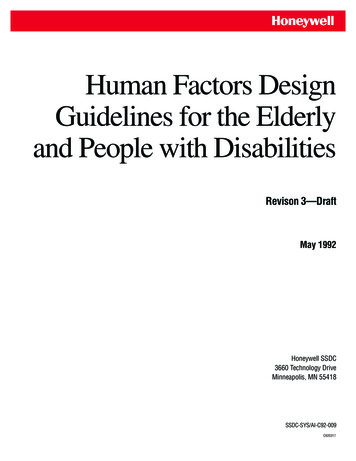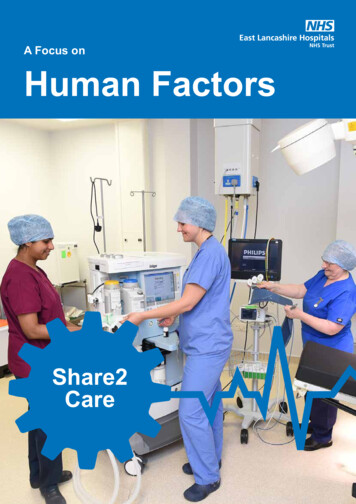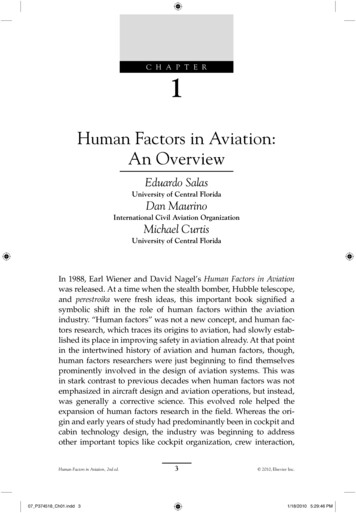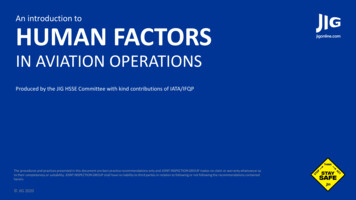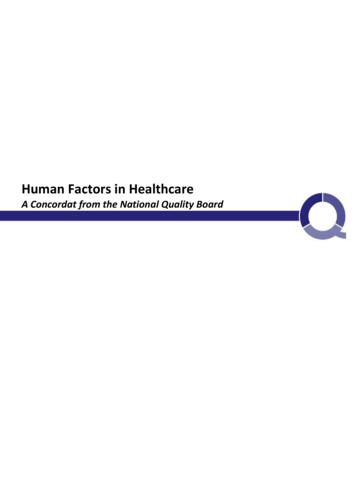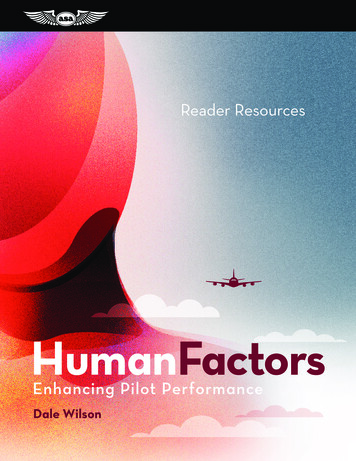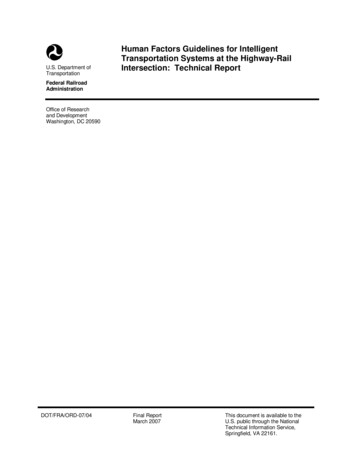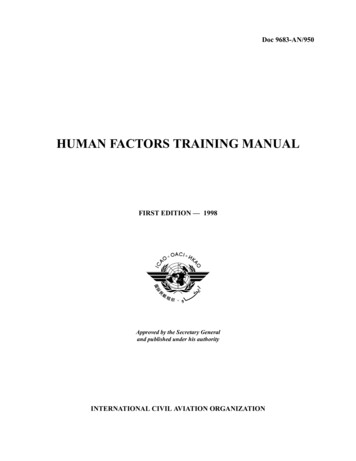
Transcription
Doc 9683-AN/950HUMAN FACTORS TRAINING MANUALFIRST EDITION — 1998Approved by the Secretary Generaland published under his authorityINTERNATIONAL CIVIL AVIATION ORGANIZATION
AMENDMENTSThe issue of amendments is announced regularly in the ICAO Journal and in themonthly Supplement to the Catalogue of ICAO Publications and Audio-visualTraining Aids, which holders of this publication should consult. The space belowis provided to keep a record of such amendments.RECORD OF AMENDMENTS AND CORRIGENDAEnteredbyNo.Dateof dEnteredbyICAO
FOREWORDSafety of the civil aviation system is the major objective of the International Civil Aviation Organization.Considerable progress has been made, but additional improvements are needed and can be achieved. It has long beenknown that some three out of four accidents result from less than optimum human performance, indicating that anyadvance in this field can be expected to have a significant impact on the improvement of flight safety.This was recognized by the ICAO Assembly, which in 1986 adopted Resolution A26-9 on Flight Safety andHuman Factors. As a follow-up to the Assembly Resolution, the Air Navigation Commission formulated the followingobjective for the task:“To improve safety in aviation by making States more aware and responsive to the importance of human factorsin civil aviation operations through the provision of practical human factors material and measures developed onthe basis of experience in States, and by developing and recommending appropriate amendments to existingmaterials in Annexes and other documents with regard to the role of human factors in the present and futureoperational environments. Special emphasis will be directed to the human factors issues that may influence thedesign, transition and in-service use of the [future] ICAO CNS/ATM systems.”One of the methods chosen to implement Assembly Resolution A26-9 was the publication of a series of digestswhich addressed various aspects of Human Factors and its impact on flight safety. These digests were intendedprimarily for use by States to increase the awareness of their personnel of the influence of human performance onsafety.The digests were aimed at the managers of both civil aviation administrations and the airline industry, includingairline operational and training managers. The target audience also included regulatory bodies, safety andinvestigation agencies and training establishments, as well as senior and middle non-operational airline management.This manual is essentially an edited compilation of the series of ICAO Human Factors digests. Its target audienceincludes senior training, operational and safety personnel in industry and regulatory bodies. It comprises two parts:Part 1 — General introduces the concept of aviation Human Factors, presents a systemic and contemporary viewof aviation safety, outlines the basic principles of workstation design and reviews the fundamental Human Factorsissues in various aviation domains, including air traffic control and maintenance.Part 2 — Training Programmes for Operational Personnel outlines Human Factors training issues and proposesthe contents of sample training curricula for pilots, air traffic controllers and accident investigators.This manual is intended to be kept up to date. It will be amended periodically as new research becomes availableto reflect increased knowledge on Human Factors training for operational personnel.(iii)
TABLE OF CONTENTSPagePART 1.GENERALChapter 1. Fundamental Human FactorsConcepts . . . . . . . . . . . . . . . . . . . . . . . . . . . . . . . .1.11.21.3Chapter 4.1-1-8List of references . . . . . . . . . . . . . . . . . . . . . .1-1-16Chapter 2. Human Factors, Managementand Organization . . . . . . . . . . . . . . . . . . . . . . . .2.12.22.32.42.5Introduction . . . . . . . . . . . . . . . . . . . . .From individuals to organizations . . .Safe and unsafe organizations . . . . . .Allocation of resources . . . . . . . . . . . .Management’s contributionto safety . . . . . . . . . . . . . . . . . . . . . . . .1-1-11-1-13.61-4-1Introduction . . . . . . . . . . . . . . . . . . . . .Basic facts about ergonomics . . . . . . .Human capabilities . . . . . . . . . . . . . . .Human information processing. . . . . .Human dimensions . . . . . . . . . . . . . . .Displays, controls and flightdeck design . . . . . . . . . . . . . . . . . . . . .The environment . . . . . . . . . . . . . . . . .1-4-11-4-11-4-41-4-81-4-101-4-121-4-25List of references . . . . . . . . . . . . . . . . . . . . . .1-4-29Chapter 5. Human Factors issues inair traffic control . . . . . . . . . . . . . . . . . . . . . . . 11Introduction . . . . . . . . . . . . . . . . . . . . .Human Factors within systems. . . . . .Automation in air traffic control . . . .The selection and training ofair traffic controllers . . . . . . . . . . . . . .The human element — specificattributes . . . . . . . . . . . . . . . . . . . . . . .1-5-16List of references . . . . . . . . . . . . . . . . . . . . . .1-5-22Appendix to Chapter 5 . . . . . . . . . . . . . . . . . .1-5-26Chapter 6. Human Factors in aircraftmaintenance and inspection . . . . . . . . . . . . . . .1-6-15.51-2-15Chapter 3. Human Factors issues in thedevelopment and implementation of CommunicationsNavigation and Surveillance/Air TrafficManagement (CNS/ATM) systems . . . . . . . . . .1-3-13.13.23.33.43.5Ergonomics . . . . . . . . . . . . . . . . . .4.14.24.34.44.54.61-1-1Introduction . . . . . . . . . . . . . . . . . . . . .The meaning of Human Factors . . . . .The industry need for HumanFactors . . . . . . . . . . . . . . . . . . . . . . . . .Human Factors applications inaviation operations . . . . . . . . . . . . . . .1.4PageIntroduction . . . . . . . . . . . . . . . . . . . . .1-3-1The ICAO CNS/ATM concept . . . . . .1-3-3Automation in advanced aviation systems 1-3-6Human-centred technology . . . . . . . . . 1-3-12Principles of human-centredautomation . . . . . . . . . . . . . . . . . . . . . .1-3-15Qualities of human-centredautomation . . . . . . . . . . . . . . . . . . . . . .1-3-196.16.26.36.4List of references . . . . . . . . . . . . . . . . . . . . . .1-3-24(v)Introduction . . . . . . . . . . . . . . . . . . . . .Human Factors — aircraftmaintenance and inspection . . . . . . . .Human error in aircraft maintenanceand inspection: an organizationalperspective. . . . . . . . . . . . . . . . . . . . . .Human Factors issues affectingaircraft maintenance . . . . . . . . . . . . . o. 2
(vi)Human Factors Training ManualPage6.5Teams and organizational issues inaircraft maintenance . . . . . . . . . . . . . .Automation and advanced technologysystems . . . . . . . . . . . . . . . . . . . . . . . .Error prevention considerationsand strategies . . . . . . . . . . . . . . . . . . . .6.66.71-6-161-6-18PageChapter 2. Crew resource management(CRM) training . . . . . . . . . . . . . . . . . . . . . . . . . .2.12.2Introduction . . . . . . . . . . . . . . . . . . . . .Crew resource management(CRM) training . . . . . . . . . . . . . . . . . .Threat and error management(TEM) training . . . . . . . . . . . . . . . . . .Guidance for integrating TEM intoCRM . . . . . . . . . . . . . . . . . . . . . . . . . .Line-oriented flight training (LOFT) .2-2-122-2-20List of recommended reading . . . . . . . . . . . .2-2-27Chapter 3. Training issues in automationand advanced technology flight decks . . . . . . .2-3-11-6-202.3List of references . . . . . . . . . . . . . . . . . . . . . .1-6-242.42.5PART 2. TRAINING PROGRAMMESFOR OPERATIONAL PERSONNELChapter 1. Basic human performance trainingprogrammes for operational personnel . . . . . 15Introduction . . . . . . . . . . . . . . . . . . . . .Human Factors training foroperational personnel: anintroduction and overview . . . . . . . . .The prior situation. . . . . . . . . . . . . . . .Human Factors highlights . . . . . . . . . .The SHEL Model . . . . . . . . . . . . . . . .The implications of the provisions fromAnnexes 1 and 6, Part I . . . . . . . . . . .Human performance trainingcurriculum: an ICAO proposal . . . . . .Human performance trainingcurriculum for pilots . . . . . . . . . . . . . .The skill requirement . . . . . . . . . . . . .Human performance trainingcurriculum for air traffic controllers. .Human performance training formaintenance technicians . . . . . . . . . . .Considerations in trainingimplementation and curriculumdevelopment . . . . . . . . . . . . . . . . . . . .Training philosophy and objectives . .Skill development, operationalpersonnel assessment and trainingcourse evaluation. . . . . . . . . . . . . . . . .Human performance training curriculumfor aircraft maintenance engineers . . .Appendix 1 to Chapter 1 . . . . . . . . . . . . . . . .Appendix 2 to Chapter 1 . . . . . . . . . . . . . . . .Appendix 3 to Chapter 1 . . . . . . . . . . . . . . . .31/5/05No. 22-1-12-2-12-2-12-2-12-2-82-1-1Introduction . . . . . . . . . . . . . . . . . . . . .An introduction to automation . . . . . .Issues and concerns in automation. . .Training for automation . . . . . . . . . . .Management techniques andcoping strategies . . . . . . . . . . . . . . . . .2-3-182-1-5List of recommended reading . . . . . . . . . . . .2-3-212-1-7Appendix 1 to Chapter 3 . . . . . . . . . . . . . . . .Appendix 2 to Chapter 3 . . . . . . . . . . . . . . . .Appendix 3 to Chapter 3 . . . . . . . . . . . . . . . .2-3-242-3-292-3-31Chapter 4. Human Factors training forsafety investigators . . . . . . . . . . . . . . . . . . . . . . n . . . . . . . . . . . . . . . . . . . . .Need for and purpose ofHuman Factors investigation . . . . . . .Conduct of the investigation. . . . . . . .Reporting and preventive action. . . . 22-4-44
PART 1GENERAL
CHAPTER 1FUNDAMENTAL HUMAN FACTORS CONCEPTS1.1INTRODUCTION1.1.1 Human performance is cited as a causal factor in the majority of aircraft accidents. If the accident rate isto be decreased, Human Factors issues in aviation must be better understood and Human Factors knowledge morebroadly and proactively applied. By proaction it is meant that Human Factors knowledge should be applied andintegrated during the systems design and certification stages, as well as during the operational personnel certificationprocess, before the systems and the people become operational. The expansion of Human Factors awareness presentsthe international aviation community with the single most significant opportunity to make aviation both safer andmore efficient. The purpose of this chapter is to present an overview of the various components which constituteHuman Factors and to clarify its meaning.1.1.2 Ever since humans began to make tools, thousands of years ago, the application of elementary ergonomicshas improved work efficiency. But it is only during the last hundred years that the modern evolution of ergonomicstowards Human Factors has begun.1.1.3 The need during the First World War to optimize factory production and to assign thousands of recruitsmore effectively to military duties, and the fact that during the Second World War sophisticated equipment wassurpassing human capability to operate it with maximum effectiveness provided further stimulus to Human Factorsprogress. Selection and training of staff, too, began to be approached more scientifically. However, it might be arguedthat the renewed interest in Human Factors contribution to aviation safety was a reactive response to technologicallimitations prevailing at the time. Therefore, human capabilities were extended to their maximum through theapplication of Human Factors knowledge, sometimes at the cost of overlooking human limitations.1.1.4 The institutionalization of Human Factors occurred with the founding of several organizations such as theErgonomics Research Society in 1949, the Human Factors Society (now Human Factors and Ergonomics Society)in 1957 and the International Ergonomics Association (IEA) in 1959.1.1.5 The recognition that basic Human Factors education was needed throughout the industry led to variousapproaches to formal training in different countries. This recognition, tragically emphasized by the investigation ofa number of accidents resulting almost entirely from deficiencies in the application of Human Factors, led ICAO toimplement Human Factors training requirements into the training and licensing requirements included in Annex 1(1989) and Annex 6 (1995), as well as into the process of accident investigations included in Annex 13 (1994).1.1.6 The 1976 agreement between the United States Federal Aviation Administration (FAA) and the NationalAeronautics and Space Administration (NASA) to establish a voluntary, non-punitive, confidential Aviation SafetyReporting System (ASRS) constituted official recognition that adequate information for analysis of human behaviourand errors in human performance is best obtained by eliminating the threat of punitive action against the personmaking the report. Similar schemes were later set up in the United Kingdom (CHIRP), Canada (CASRP) andAustralia (CAIR).1-1-1
1-1-2Human Factors Training Manual1.1.7 This chapter outlines:1) the meaning and definition of Human Factors, a conceptual model of it, and clarification of commonmisconceptions;2) the industry need for Human Factors; and3) a brief overview of the application of Human Factors in flight operations.1.2THE MEANING OF HUMAN FACTORS1.2.1 Human Factors as a term has to be clearly defined because when these words are used in the vernacularthey are often applied to any factor related to humans. The human element is the most flexible, adaptable and valuablepart of the aviation system, but it is also the most vulnerable to influences which can adversely affect its performance.Throughout the years, some three out of four accidents have resulted from less than optimum human performance.This has commonly been classified as human error.1.2.2 The term “human error” is of no help in accident prevention because although it may indicate WHEREin the system a breakdown occurs, it provides no guidance as to WHY it occurs. An error attributed to humans in thesystem may have been design-induced or stimulated by inadequate training, badly designed procedures or the poorconcept or layout of checklists or manuals. Further, the term “human error” allows concealment of the underlyingfactors which must be brought to the fore if accidents are to be prevented. In fact, contemporary safety-thinkingargues that human error should be the starting point rather than the stop-rule in accident investigation and prevention.1.2.3 An understanding of the predictable human capabilities and limitations and the application of thisunderstanding are the primary concerns of Human Factors. Human Factors has been progressively developed, refinedand institutionalized since the end of the last century, and is now backed by a vast store of knowledge which can beused by those concerned with enhancing the safety of the complex system which is today’s civil aviation. Throughoutthis manual capital initial letters are used for the term “Human Factors”. The terms “human aspects” and “humanelements” in common usage are helpful alternatives to avoid ambiguity and aid comprehension.The disciplines of Human Factors1.2.4 Many of the early concerns in aviation were related to the effects on people of noise, vibration, heat, coldand acceleration forces. Usually, the person nearest at hand with a knowledge of physiology was a physician; this mayhave generated one of the more persistent misconceptions about Human Factors, the belief that it is somehow a branchof medicine. Yet half a century ago work was expanding on the more cognitive aspects of aviation tasks and this trendhas continued and is outside the scope of medicine. Optimizing the role of people in this complex workingenvironment involves all aspects of human performance: decision-making and other cognitive processes; the designof displays and controls and flight deck and cabin layout; communication and computer software; maps and charts;and the field of documentation such as aircraft operating manuals, checklists, etc. Human Factors knowledge is alsoincreasingly used in staff selection, training and checking and in accident prevention and investigation.1.2.5 Human Factors is multidisciplinary in nature. For example, information is drawn from psychology tounderstand how people process information and make decisions. From psychology and physiology comes anunderstanding of sensory processes as the means of detecting and transmitting information on the world about us. Themeasures and movements of the body — essential in optimizing the design and layout of controls, and other
Chapter 1. Fundamental Human Factors Concepts1-1-3workplace characteristics of the flight deck and cabin — call upon anthropometry and biomechanics. Biology andits increasingly important sub-discipline, chronobiology, are needed to understand the nature of the body’s rhythmsand sleep, and their effects in night flying and time-zone changes. No proper analysis or presentation of data fromsurveys or studies is possible without some basic understanding of statistics. While utilizing these academic sourcesof knowledge, Human Factors is essentially concerned with solving practical problems in the real world. HumanFactors is practical in nature; it is problem-oriented rather than discipline-centred.1.2.6 Human Factors is about people in their living and working situations; about their relationship withmachines, with procedures and with the environment about them; and also about their relationships with other people.One definition of Human Factors, as proposed by Professor Edwards, declares that “Human Factors is concerned tooptimize the relationship between people and their activities, by the systematic application of human sciences,integrated within the framework of systems engineering”. Its objectives can be seen as effectiveness of the system,which includes safety and efficiency, and the well-being of the individual. Professor Edwards further elaborates that“activities” indicates an interest in communication between individuals and in the behaviour of individuals andgroups. Lately, this has been expanded upon to include the interactions among individuals and groups and theorganizations to which they belong, and to the interactions among the organizations that constitute the aviationsystem. The human sciences study the structure and nature of human beings, their capabilities and limitations, andtheir behaviours both singly and in groups. The notion of integration within systems engineering refers to the HumanFactors practitioner’s attempts to understand the goals and methods as well as the difficulties and constraints underwhich people working in interrelated areas of engineering must make decisions. Human Factors uses this informationbased on its relevance to practical problems.1.2.7 The term “ergonomics” derives from the Greek words “ergon” (work) and “nomos” (natural law). It isdefined as “the study of the efficiency of persons in their working environment”. In some States, the term ergonomicsis used strictly to refer to the study of human-machine system design issues. Chapter 4 introduces a discussion onergonomics.A conceptual model of Human Factors1.2.8 It is helpful to use a model to aid in the understanding of Human Factors, as this allows a gradual approachto comprehension. One practical diagram to illustrate this conceptual model uses blocks to represent the differentcomponents of Human Factors. The model can then be built up one block at a time, with a pictorial impression beinggiven of the need for matching the components. The SHEL concept (the name being derived from the initial lettersof its components, Software, Hardware, Environment, Liveware) was first developed by Edwards in 1972, with amodified diagram to illustrate the model developed by Hawkins in 1975. The following interpretations are suggested:liveware (human), hardware (machine), software (procedures, symbology, etc.), and environment (the situation inwhich the L-H-S system must function). This building block diagram does not cover the interfaces which are outsideHuman Factors (hardware-hardware; hardware-environment; software-hardware) and is only intended as a basic aidto understanding Human Factors.1.2.9 Liveware. In the centre of the model is a person, the most critical as well as the most flexible componentin the system. Yet people are subject to considerable variations in performance and suffer many limitations, most ofwhich are now predictable in general terms. The edges of this block are not simple and straight, and so the othercomponents of the system must be carefully matched to them if stress in the system and eventual breakdown are tobe avoided.
1-1-4Human Factors Training ManualHSLS Software (procedures, symbology, etc.)H Hardware (machine)E EnvironmentL Liveware (human)LEIn this model the match or mismatch of theblocks (interface) is just as important as thecharacteristics of the blocks themselves. Amismatch can be a source of human error.The SHEL model as modified by Hawkins1.2.10 In order to achieve this matching, an understanding of the characteristics of this central component isessential. Some of the more important characteristics are the following:a) Physical size and shape. In the design of any workplace and most equipment, a vital role is played by bodymeasurements and movements, which will vary according to age and ethnic and gender groups. Decisionsmust be made at an early stage in the design process, and the data for these decisions are available fromanthropometry and biomechanics.b) Physical needs. People’s requirements for food, water and oxygen are available from physiology and biology.c) Input characteristics. Humans have been provided with a sensory system for collecting information from theworld around them, enabling them to respond to external events and to carry out the required task. But allsenses are subject to degradation for one reason or another, and the sources of knowledge here arephysiology, psychology and biology.d) Information processing. These human capabilities have severe limitations. Poor instrument and warningsystem design has frequently resulted from a failure to take into account the capabilities and limitations ofthe human information processing system. Short- and long-term memory are involved, as well as motivationand stress. Psychology is the source of background knowledge here.e) Output characteristics. Once information is sensed and processed, messages are sent to the muscles to initiatethe desired response, whether it be a physical control movement or the initiation of some form ofcommunication. Acceptable control forces and direction of movement have to be known, and biomechanics,physiology and psychology provide such knowledge.
Chapter 1. Fundamental Human Factors Conceptsf)1-1-5Environmental tolerances. Temperature, pressure, humidity, noise, time of day, light and darkness can all bereflected in performance and also in well-being. Heights, enclosed spaces and a boring or stressful workingenvironment can also be expected to influence performance. Information is provided here by physiology,biology and psychology.The Liveware is the hub of the SHEL model of Human Factors. The remaining components must be adapted andmatched to this central component.1.2.11Liveware-Hardware. This interface is the one most commonly considered when speaking ofhuman-machine systems: design of seats to fit the sitting characteristics of the human body, of displays to match thesensory and information processing characteristics of the user, of controls with proper movement, coding and location.The user may never be aware of an L-H deficiency, even where it finally leads to disaster, because the natural humancharacteristic of adapting to L-H mismatches will mask such a deficiency, but will not remove its existence. Thisconstitutes a potential hazard to which designers should be alert. With the introduction of computers and advancedautomated systems, this interface has repositioned itself at the forefront of Human Factors endeavours.1.2.12 Liveware-Software. This encompasses humans and the non-physical aspects of the system such asprocedures, manual and checklist layout, symbology and computer programmes. Liveware-software problems areconspicuous in accident reports, but they are often difficult to observe and are consequently more difficult to resolve(for example, misinterpretation of checklists or symbology, non-compliance with procedures, etc.).1.2.13 Liveware-Environment. The human-environment interface was one of the earliest recognized in flying.Initially, the measures taken all aimed at adapting the human to the environment (helmets, flying suits, oxygen masks,anti-G suits). Later, the trend was to reverse this process by adapting the environment to match human requirements(pressurization and air-conditioning systems, soundproofing). Today, new challenges have arisen, notably ozoneconcentrations and radiation hazards at high flight levels and the problems associated with disturbed biologicalrhythms and related sleep disturbance and deprivation as a consequence of the increased speed of transmeridian travel.Since illusions and disorientation are at the root of many aviation accidents the L-E interface must consider perceptualerrors induced by environmental conditions, for example, illusions during approach and landing phases. The aviationsystem also operates within the context of broad political and economical constraints, and those aspects of theenvironment will interact in this interface. Although the possibility of modifying these influences is sometimes beyondHuman Factors practitioners, their incidence is central and should be properly considered and addressed by those inmanagement with the possibility to do so. This topic is fully developed in Chapter 2.1.2.14Liveware-Liveware. This is the interface between people. Training and proficiency testing havetraditionally been done on an individual basis. If each individual team member was proficient, then it was assumedthat the team consisting of these individuals would also be proficient and effective. This is not always the case,however, and for many years attention has increasingly turned to the breakdown of teamwork. Flight crews, air trafficcontrollers, maintenance technicians and other operational personnel function as groups and group influences playa role in determining behaviour and performance. In this interface, we are concerned with leadership, crewco-operation, teamwork and personality interactions. Staff/management relationships are also within the scope of thisinterface, as corporate culture, corporate climate and company operating pressures can significantly affect humanperformance. Part 2 of this manual describes current industry approaches to Human Factors training programmes foroperational personnel.1.3THE INDUSTRY NEED FOR HUMAN FACTORS1.3.1 Admiral Donald Engen, the former Administrator of the United States Federal Aviation Administration,has been quoted as saying (1986): “We spent over fifty years on the hardware, which is now pretty reliable. Now it’s
1-1-6Human Factors Training Manualtime to work with people.” This declaration somehow sets the foundation upon which the industry need for HumanFactors can be assessed. Curiously enough, we retain a lawyer for advice about a legal problem, or hire an architectto build a house, or consult a physician when trying to establish the diagnosis of a medical problem, but when itcomes to solving Human Factors problems, we have adopted an intuitive and in many cases perfunctory approach,even though many lives may depend on the outcome. A background of many years of industry experience orthousands of flying hours may have little or no significance when looking for the resolution of problems which onlya thorough understanding of Human Factors can provide.1.3.2 This is of special significance because, as already mentioned, it has long been known that some three outof four accidents result from performance errors made by apparently healthy and properly certificated individuals.The sources of some of these errors may be traced to poor equipment or procedure design or to inadequate trainingor operating instructions. But whatever the origin, the question of human performance capabilities and limitationsand human behaviour is central to the technology of Human Factors. The cost, both in human and financial terms,of less than optimum human performance has become so great that a makeshift or intuitive approach to HumanFactors is no longer appropriate. Safety being the ultimate objective of all those involved in aviation, its logicalfollow-up is to ensure a proper level of Human Factors knowledge throughout the industry.1.3.3 The industry need for Human Factors is based on its impact on two broad areas, which interrelate soclosely that in many cases their influences overlap and factors affecting one may also affect the other. These areasare: Effectiveness of the system— safety— efficiency Well-being of operational personnel.Effectiveness of the systemSafety1.3.4 The best way to illustrate the effect of Human Factors issues on aviation safety is through the example ofaccidents. A few accidents in which aspects of Human Factors
FUNDAMENTAL HUMAN FACTORS CONCEPTS 1.1 INTRODUCTION 1.1.1 Human performance is cited as a causal factor in the majority of aircraft accidents. If the accident rate is to be decreased, Human Factors issues in aviation must be better understood and Human Factors
